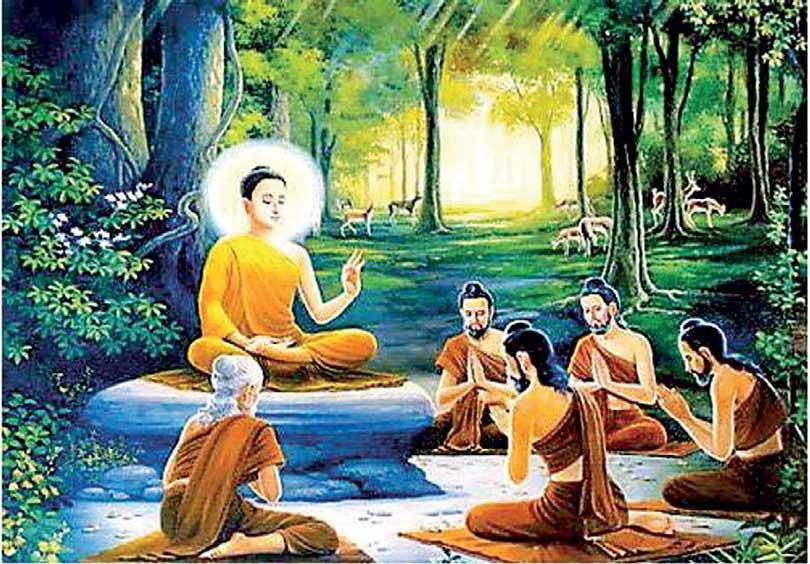23 Jul 2021 - {{hitsCtrl.values.hits}}

 The Bodisatva as a prince was conceived by Queen Mahamaya after 20 years, when King Suddhodana and his queen Mahamaya were without children, which happened on Esala Poya. It was also the day when Gautama Buddha arrived at the Deer park of Isipathana to preach to the first five ascetics, Kondanga, Vappa, Bhadiya, Mahanama and Assaji.
The Bodisatva as a prince was conceived by Queen Mahamaya after 20 years, when King Suddhodana and his queen Mahamaya were without children, which happened on Esala Poya. It was also the day when Gautama Buddha arrived at the Deer park of Isipathana to preach to the first five ascetics, Kondanga, Vappa, Bhadiya, Mahanama and Assaji.
To us in Sri Lanka, Esala especially signifies the first ordination of a man of the soil Prince Arittha who entered the order at Anuradhapura under Arahat Mahinda. Which enhances the value of Esala poya to Sri Lankan Buddhists, following the introduction of Buddhism? On this day took place the laying of the foundation for the Maha Chetiya or Stupa, Ruwanvelisaya and also its enshrinement of relics by King Dutugemunu. The combination of all these events brings to all peoples of Sri Lanka and especially Buddhists to observe Esala festivals throughout the country, Queen Mahamaya had woken on Esala Poya day and conveyed to King Suddhodana of a dream that she had witnessed during the night and King Suddhodana who was well versed with worldly matters knew that something important should happen in the Kingdom.
The dream that was related by her to the King said that, four guardian deities carried the Queen in couch full of flowers to the snow-clad Himalayan Mountain Range, when a white baby elephant that carried a white lotus flower on its trunk circle thrice round the couch and thereon the baby elephant entered into her womb from the right side of the abdomen. She told the King that she was awoken by this dream and asked him as to what it means. The Prince who was to be King after King Suddodahana spent a luxurious life but during that time he came to think that life was impermanent and full of sufferings. At the age of 29, on Esala Poya Day he decided to leave the comfort he enjoyed to bring the universal truth of suffering and how it could be solved. Therefore he gained the absolute truth of suffering and attained Nibbana.
After the first discourse at Sarnath of Dhammacakkappavattana Sutta, the eldest of the five, Kondana arrived at the first stage of Nirvana. The other four attained the status of Arahat. While this was so, in Sri Lanka in every village, the devotees prepare themselves to invite monks to observe ‘Vas ‘for the next three months. In an announcement on Tuesday made by the two Maha Vihares’ the Temples are open to the devotees with conditions of Health Guidelines. This is expected to be a relief to most people in the villages. On the other hand, the invitation to the monks who have been conferred Upasamapda is also a blessings to the prealates because it is the Crowning moment for monks in his path for Nirvana or eternal bliss.
Unfortunately, for the last two years nearly two thousand Samaneara monks are awaiting to be conferred with Upasamapda and these rites were postponed due to the pandemic that was raging in the country It is a ritual in the villages in the country when the devotees band themselves together to select a monk or monks to be invited to observe ‘Vas ‘in their own temples. Normally the monk who is residing in the Temple comes first and then some others monks are also invited according to the strength of the Village and the number of people who could afford to upkeep the monks during the period of ‘ Vas ‘. Buddha had advised the five monks to observe “Vdharasana Bhavana “and also made the devotees partake of the merits. They were expected to be in one place and not move about during the rainy season, when plant life and small animal life would be trampled and thereby a sin would be committed. This led to the present practice of “Vas “all over the country, when monks are invited to observe ‘Vas ‘in their respective temples or Aramaya’s or sometimes in specially built enclosures where there are no Temples, but with only people.
The observance of Vas by the Maha Sangha during the rainy season was introduced by Gautama Buddha when he was with the five monks. The commencement of the rainy season began from the month of Esala. Vas signifies the cessation from going about begging alms (Pindapatha) during the rainy season for the monks residing in a definite place, either in a sanctuary of their respective viharas or in a particular abode. Buddhist laity provided the monks with food, robes and other necessities during the rainy season. In return for this gesture, the monks were told by Gautama Buddha to engage in the practice of ‘Vidharshana Bhavana’ meditation and make the laity partake of the merit. An additional factor that enhances the value of this poya to Sri Lanka is the first local ordination of a Sri Lankan, when Prince Arittha, the nephew of the king, entered the Order at Anuradhapura, under Arahant Mahinda, following the introduction of Buddhism. On this day there also took place the laying of the foundation for the celebrated dagoba, the Mahastupa or the Ruwanvelisaya and also its enshrinement of relics by King Dutugemunu. It is owing to the combination of all these events that the Sinhala Buddhists fittingly observe this day ceremonially by holding Esala festivals throughout the island, giving pride of place to the internationally famous Kandy Esala Perahera The Prince lived a luxurious life.
He realized that life was impermanent and full of suffering. Therefore, he was always determined to find a path or a way to solve the problems of universal suffering. At the age of 29, the prince decided to leave the palace, leaving all comforts to find the way out of universal suffering. The great Renunciation also took place on an Esala Full Moon Poya Day, 2,600 years ago, considered a bold step for the salvation of mankind It was on the Esala Poya Day, seven weeks after the attainment of Buddhahood, Gautama Buddha delivered His first discourse, the Dhammachakkapavattna Sutta (the wheel of truth) to the five Ascetics, Kondanna, Vappa, Bhaddiya, Mahanama and Assaji at Isipathanaya in Benares . The sermon consisted of the central teachings of Gautama Buddha – the Four Noble Truths and the Noble Eightfold Path. At the end of the Sutta the eldest Kondangna Thera attained sotapatti. ”Hearing the discourse, the other four ascetics later attained the status of Arahat. The five ascetics were the first disciples of Gautama Buddha. He spent three months with these monks in Isipatanaramaya.” The observance of Vas by the Maha Sangha during the rainy season was introduced by Gautama Buddha when he was with the five monks.
The commencement of the rainy season began from the month of Esala. Vas signifies the cessation from going about begging for alms during the rainy season for the monks residing in a definite place, either in a sanctuary of their respective viharas or in a particular abode. Buddhist laity provided the monks with food and other necessities during the rainy season. In return for this gesture, the monks were told by Gautama Buddha to engage in the practice of ‘Vidharshana Bhavana’ meditation and make the laity partake of the merit. Furthermore, Esala also signifies a number of important events in the life of Gautama Buddha. The convocation of the first Buddhist Council was held on the Esala Poya Day under the patronage of King Ajasaththa, three months after the Parinibbana of Gautama Buddha at the Satipattana cave on the vehera rock near Rajagaha. It was headed by the Ven. Maha Kassapa with the participation of 500 Arahats. It was on the same Esala Full Moon Poya Day, that Prince Rahula, the only child of Prince Siddartha and Princess Yasodara was born.
24 Dec 2024 5 hours ago
24 Dec 2024 6 hours ago
24 Dec 2024 8 hours ago
24 Dec 2024 9 hours ago
24 Dec 2024 24 Dec 2024